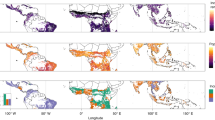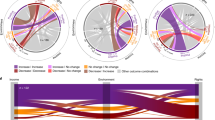Abstract
Complex and variable ecological and social settings make the programme on reducing emissions through avoided deforestation, forest degradation and other forestry activities in developing countries (REDD+) a challenging policy to design. The total value to society of each type of REDD+ outcome is dependent on the fundamentally different risk profiles of alternative forest-management approaches and their scope and potential for co-benefits. We suggest a modular policy framework for REDD+ that distinguishes and differentially compensates the distinct outcomes. This could represent an improved framework to promote and manage incentives for effective forest-carbon initiatives, offer better scope to find common ground in policy negotiations and allow faster adaptation of policy to an uncertain future.
This is a preview of subscription content, access via your institution
Access options
Subscribe to this journal
Receive 12 print issues and online access
$209.00 per year
only $17.42 per issue
Buy this article
- Purchase on Springer Link
- Instant access to full article PDF
Prices may be subject to local taxes which are calculated during checkout

Similar content being viewed by others
References
UNFCCC Outcome of the Work of the Ad Hoc Working Group on Long-term Cooperative Action under the Convention Draft Decision -/CP.16 (2010); available at http://unfccc.int/files/meetings/cop_16/application/pdf/cop16_lca.pdf.
Venter, O. et al. Carbon payments as a safeguard for threatened tropical mammals. Conserv. Lett. 2, 123–129 (2009).
Stickler, C. M. et al. The potential ecological costs and cobenefits of REDD: A critical review and case study from the Amazon region. Glob. Change Biol. 15, 2803–2824 (2009).
Asquith, N. M., Vargas Ríos, M. T. & Smith, J. Can forest-protection carbon projects improve rural livelihoods? Analysis of the Noel Kempff Mercado climate action project, Bolivia. Mitig. Adapt. Strat. Glob. Change 7, 323–337 (2002).
Clements, G. R. et al. Cautious optimism over Norway–Indonesia REDD Pact. Conserv. Biol. 24, 1437–1438 (2010).
Oslo Climate and Forest Conference Interim REDD+ Partnership Document as Adopted 27th May 2010 at the Oslo Climate and Forest Conference (OCFC, 2010).
Kaimowitz, D. The prospects for reduced emissions from deforestation and degradation (REDD) in mesoamerica. Int. For. Rev. 10, 485–495 (2008).
Harvey, C. A., Dickson, B. & Kormos, C. Opportunities for achieving biodiversity conservation through REDD. Conserv. Lett. 3, 53–61 (2010).
Pistorius, T., Schmitt, C. B., Benick, D. & Entenmann, S. Greening REDD+: Challenges and Opportunities for Forest Biodiversity Conservation Policy Paper (Univ. Freiberg, 2010).
Dickson, B., Dunning, E., Killen, S., Miles, L. & Pettorelli, N. Carbon Markets and Forest Conservation: A Review of the Environmental Benefits of REDD Mechanisms (UNEP World Conservation Monitoring Centre, 2009).
Clements, T. Reduced expectations: the political and institutional challenges of REDD+. Oryx 44, 309–310 (2010).
Corbera, E. & Schroeder, H. Governing and implementing REDD+. Environ. Sci. Policy 14, 89–99 (2010).
Lambin, E. F., Geist, H. J. & Lepers, E. Dynamics of land-use and land-cover change in tropical regions. Annu. Rev. Environ. Resour. 28, 205–241 (2003).
Bekessy, S. A. & Wintle, B. A. Using carbon investment to grow the biodiversity bank. Conserv. Biol. 22, 510–513 (2008).
Boyd, E. et al. Reforming the CDM for sustainable development: Lessons learned and policy futures. Environ. Sci. Policy 12, 820–831 (2009).
Olsen, K. The Clean Development Mechanism's contribution to sustainable development: A review of the literature. Climatic Change 84, 59–73 (2007).
Andersson, K. & Gibson, C. C. Decentralized governance and environmental change: Local institutional moderation of deforestation in Bolivia. J. Policy Anal. Manag. 26, 99–123 (2007).
Kaimowitz, D. Forestry assistance and tropical deforestation: Why the public doesn't get what it pays for. Int. For. Rev. 2, 225–231 (2000).
UNFCCC The Marrakesh Accords: Report of the Conference of the Parties on its seventh session, held at Marrakesh from 29 October to 10 November 2001 FCCC/CP/2001/13/Add.1. (UNFCCC, 2001).
Moss, N. & Nussbaum, R. A Review of the Three REDD+ Safeguard Initiatives (UN-REDD Programme and the Forest Carbon Partnership Facility, 2011).
Meijaard, E. et al. Report on Barriers and Constraints to Ecosystem Services Certification Occasional Paper 66, (CIFOR, 2011).
Sovacool, B. K. The policy challenges of tradable credits: A critical review of eight markets. Energ. Policy 39, 575–585 (2011).
Olsen, K. H. & Fenhann, J. Sustainable development benefits of Clean Development Mechanism projects: A new methodology for sustainability assessment based on text analysis of the project design documents submitted for validation. Energ. Policy 36, 2819–2830 (2008).
Hamilton, K., Sjardin, M., Peters-Stanley, M. & Marcello, T. Building Bridges: State of the Voluntary Carbon Markets 2010 (Ecosystem Marketplace and Bloomberg New Energy Finance, 2010).
Nussbaumer, P. On the contribution of labelled certified emission reductions to sustainable development: A multi-criteria evaluation of CDM projects. Energ. Policy 37, 91–101 (2009).
Auld, G., Gulbrandsen, L. H. & McDermott, C. L. Certification schemes and the impacts on forests and forestry. Annu. Rev. Environ. Resour. 33, 187–211 (2008).
Dinerstein, E., Varma, K., Wikramanayake, E. & Lumpkin, S. Wildlife Premium Market +REDD (Concept document floated at CBD COP 10, Nagaoya, October 2010).
Xuemei, L. Rent extraction with a type-by-type scheme: An instrument to incorporate sustainable development into the CDM. Energ. Policy 36, 1873–1878 (2008).
Francois, M. & Hamaide, B. Certified emission reductions weights for improved CDM projects. Environ. Policy Governance 21, 31–41 (2011).
Carbon Credits (Carbon Farming Initiative) Act 2011 (Australian Government, 2011).
Marland, G., Fruit, K. & Sedjo, R. Accounting for sequestered carbon: the question of permanence. Environ. Sci. Policy 4, 259–268 (2001).
Chan, M. Lessons learned from the financial crisis: Designing carbon markets for environmental effectiveness and financial stability. CCLR 3, 152–160 (2009).
Pattanayak, S. K., Wunder, S. & Ferraro, P. J. Show me the money: Do payments supply environmental services in developing countries? Rev. Environ. Econ. Policy 4, 254–274 (2010).
Barlow, J. et al. Quantifying the biodiversity value of tropical primary, secondary, and plantation forests. Proc. Natl Acad. Sci. USA 104, 18555–18560 (2007).
Dent, D. H. Defining the conservation value of secondary tropical forests. Anim. Conserv. 13, 14–15 (2010).
Berry, N. J. et al. The high value of logged tropical forests: Lessons from northern Borneo. Biodivers. Conserv. 19, 985–997 (2010).
Martina, J. The role of forestry projects in the clean development mechanism. Environ. Sci. Policy 8, 87–104 (2005).
Schlamadinger, B. et al. A synopsis of land use, land-use change and forestry (LULUCF) under the Kyoto Protocol and Marrakech Accords. Environ. Sci. Policy 10, 271–282 (2007).
Lederer, M. From CDM to REDD+ — what do we know for setting up effective and legitimate carbon governance? Ecol. Econ. 70, 1900–1907 (2011).
Thomas, S., Dargusch, P., Harrison, S. & Herbohn, J. Why are there so few afforestation and reforestation clean development mechanism projects? Land Use Policy 27, 880–887 (2010).
Neeff, T. & Ascui, F. Lessons from carbon markets for designing an effective REDD architecture. Clim. Policy 9, 306–315 (2009).
Johns, T. et al. A three-fund approach to incorporating government, public and private forest stewards into a REDD funding mechanism. Int. For. Rev. 10, 458–464 (2008).
Lindenmayer, D. B., Hunter, M. L., Burton, P. J. & Gibbons, P. Effects of logging on fire regimes in moist forests. Conserv. Lett. 2, 271–277 (2009).
Gibson, L. et al. Primary forests are irreplaceable for sustaining tropical biodiversity. Nature 478, 378–381 (2011).
Laurance, W. F. Forest–climate interactions in fragmented tropical landscapes. Phil. Trans. R. Soc. Lond. B 359, 345–352 (2004).
Kauffman, J. B., Hughes, R. F. & Heider, C. Carbon pool and biomass dynamics associated with deforestation, land use, and agricultural abandonment in the neotropics. Ecol. Appl. 19, 1211–1222 (2009).
Dixon, R. K. et al. Carbon pools and flux of global forest ecosystems. Science 263, 185–190 (1994).
Chmura, G. L., Anisfeld, S. C., Cahoon, D. R. & Lynch, J. C. Global carbon sequestration in tidal, saline wetland soils. Glob. Biogeochem. Cycles 17, 1111–1123 (2003).
Page, S. E. et al. The amount of carbon released from peat and forest fires in Indonesia during 1997. Nature 420, 61–65 (2002).
Ronnback, P. The ecological basis for economic value of seafood production supported by mangrove ecosystems. Ecol. Econ. 29, 235–252 (1999).
Keddy, P. A. Wetland Ecology: Principles and Conservation (Cambridge Univ. Press, 2010).
Paoli, G. et al. Biodiversity conservation in the REDD. Carbon Bal. Manage. 5, 7–16 (2010).
Prins, G. et al. The Hartwell Paper: A New Direction for Climate Policy after the Crash of 2009 (Institute for Science, Innovation & Society, University of Oxford; LSE Mackinder Programme, London School of Economics and Political Science, 2010).
Guidon, P. Voluntary Carbon Markets: How Can They Serve Climate Change Policies OECD Environment Working Paper 19 (OECD, 2010).
Wara, M. Is the global carbon market working? Nature 445, 595–596 (2007).
Ostrom, E. A Polycentric Approach for Coping with Climate Change (World Bank, 2009).
McGrath, C. Does Environmental Law Work? How to Evaluate the Effectiveness of an Environmental Legal System (Lambert Academic, 2010).
Walker, W. E., Rahman, S. A. & Cave, J. Adaptive policies, policy analysis, and policy-making. Eur. J. Oper. Res. 128, 282–289 (2001).
Wunder, S. Moving Ahead with REDD+: Issues, Options, and Implications Ch. 7 (Centre for International Forestry Research, 2008).
Luyssaert, S. et al. Old-growth forests as global carbon sinks. Nature 455, 213–215 (2008).
Hobbs, R. J. et al. Novel ecosystems: Theoretical and management aspects of the new ecological world order. Glob. Ecol. Biogeogr. 15, 1–7 (2006).
Acknowledgements
The opinions expressed here are those of the authors and do not necessarily represent those of their respective institutions. We thank L. Hovani for providing critical review and A. Riedel for graphic design.
Author information
Authors and Affiliations
Corresponding author
Ethics declarations
Competing interests
The authors declare no competing financial interests.
Rights and permissions
About this article
Cite this article
Law, E., Thomas, S., Meijaard, E. et al. A modular framework for management of complexity in international forest-carbon policy. Nature Clim Change 2, 155–160 (2012). https://doi.org/10.1038/nclimate1376
Published:
Issue Date:
DOI: https://doi.org/10.1038/nclimate1376
This article is cited by
-
\(\hbox {CO}_2\) CO 2 -intensive power generation and REDD-based emission offsets with a benefit-sharing mechanism
Energy Systems (2017)
-
Strategies for improving adaptation practice in developing countries
Nature Climate Change (2014)



